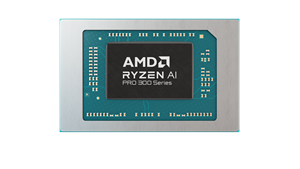1 As of May 2023, AMD has the first available dedicated AI engine on an x86 Windows processor, where 'dedicated AI engine' is defined as an AI engine that has no function other than to process AI inference models and is part of the x86 processor die. For detailed information, please check: https://www.amd.com/en/technologies/xdna.html. PHX-3a.
2 All battery life claims are approximate. Actual battery life will vary based on several factors, including, but not limited to: product configuration and usage, software, operating conditions, wireless functionality, power management settings, screen brightness and other factors. The maximum capacity of the battery will naturally decrease with time and use. AMD has not independently tested or verified the battery life claim. GD-168.
3 Based on AMD product specifications and competitive products announced as of Oct 2024. AMD Ryzen™ AI PRO 300 Series processors’ NPU offers up to 55 peak TOPS. This is the most TOPS offered on any system found in enterprise today. AI PC is defined as a laptop PC with a processor that includes a neural processing unit (NPU). STXP-06.
4 Based on TOPS specification of AMD Ryzen™ AI 300 Series processors with 50 TOPS compared to an AMD Ryzen 8040 Series processors with 16 TOPS as of June 2024. STX-01.
5 Based on product specifications and competitive products announced as of Oct 2024 and testing as of Sept 2024 by AMD performance labs using the following systems: HP EliteBook X G1a with AMD Ryzen AI 9 HX PRO 375 processor @23W, Radeon 880M graphics, 32GB of RAM, 512GB SSD, VBS=ON, Windows 11 PRO; Dell Latitude 7450 with Intel Core Ultra 7 165U processor @15W (vPro enabled), Intel Iris Xe Graphics, VBS=ON, 32GB RAM, 512GB NVMe SSD, Microsoft Windows 11 Professional; Dell Latitude 7450 with Intel Core Ultra 7 165H processor @28W (vPro enabled), Intel Iris Xe Graphics, VBS=ON, 16GB RAM, 512GB NVMe SSD, Microsoft Windows 11 Pro. All systems were tested in Best Performance Mode. AI PC is defined as a laptop PC with a processor that includes a neural processing unit (NPU). STXP-04.
6 Testing as of Sept 2024 by AMD performance labs on an HP EliteBook X G1a (14in) (40W) with AMD Ryzen AI 9 HX PRO 375 processor, Radeon™ 890M graphics, 32GB of RAM, 512GB SSD, VBS=ON, Windows 11 Pro vs. a Dell Latitude 7450 with an Intel Core Ultra 7 165H processor (vPro enabled), Intel Arc Graphics, VBS=ON, 16GB RAM, 512GB NVMe SSD, Microsoft Windows 11 Pro in the application(s) (Best Performance Mode): Cinebench R24 nT. Laptop manufactures may vary configurations yielding different results. STXP-12.
7 Testing as of Sept 2024 by AMD performance labs using the following systems: (1) HP EliteBook X G1a with AMD Ryzen AI 9 HX PRO 375 processor (@40W), Radeon™ 890M graphics, 32GB of RAM, 512GB SSD, VBS=ON, Windows 11 Pro; (2) Dell Latitude 7450 with Intel Core Ultra 7 165U processor (@15W) (vPro enabled), Intel Iris Xe Graphics, VBS=ON, 32GB RAM, 512GB NVMe SSD, Microsoft Windows 11 Professional; and (3) Dell Latitude 7450 with Intel Core Ultra 7 165H processor (@28W) (vPro enabled), Intel Integrated, VBS=ON, 16GB RAM, 512GB NVMe SSD, Microsoft Windows 11 Pro. Tested applications (in Balanced Mode) include: Procyon Office Productivity, Procyon Office Productivity Excel, Procyon Office Productivity Outlook, Procyon Office Productivity Power Point, Procyon Office Productivity Word, Composite Geomean Score. Laptop manufactures may vary configurations yielding different results. STXP-18.
8 Based on Microsoft Copilot+ requirements of minimum 40 TOPS using AMD product specifications and competitive products announced as of Oct 2024. Microsoft requirements found here - https://support.microsoft.com/en-us/topic/copilot-pc-hardware-requirements-35782169-6eab-4d63-a5c5-c498c3037364. STXP-05.
9 Trillions of Operations per Second (TOPS) for an AMD Ryzen processor is the maximum number of operations per second that can be executed in an optimal scenario and may not be typical. TOPS may vary based on several factors, including the specific system configuration, AI model, and software version. GD-243.
10 Testing as of Sept 2024 by AMD performance labs using the following benchmarks: Blender, Cinebench R24, Geekbench 6.3, and Passmark 11, systems: HP EliteBook X G1a with AMD Ryzen AI 9 HX PRO 375 processor @54W, Radeon 880M graphics, 32GB of RAM, 512GB SSD; Lenovo ThinkPad T14s Gen 6 with AMD Ryzen™ AI 7 PRO 360 processor @22W, Radeon™ 880M graphics, 32GB RAM, 1TB SSD; Dell Latitude 7450 with Intel Core Ultra 7 165U processor @15W (vPro enabled), Intel Iris Xe Graphics, 32GB RAM, 512GB NVMe SSD; Dell Latitude 7450 with Intel Core Ultra 7 165H processor @28W (vPro enabled), Intel Iris Xe Graphics, 16GB RAM, 512GB NVMe SSD,. All systems Windows 11 Pro, VBS=ON, and tested in Best Performance Mode. PassMark is a registered trademark of PassMark Software Pty Ltd. AI PC is defined as a laptop PC with a processor that includes a neural processing unit (NPU). STXP-07.
11 Boost Clock Frequency is the maximum frequency achievable on the CPU running a bursty workload. Boost clock achievability, frequency, and sustainability will vary based on several factors, including but not limited to: thermal conditions and variation in applications and workloads. GD-150
12 The AMD Secure Processor is a dedicated on-chip security processor integrated within each system-on-a-chip (SoC) and ASIC (Application Specific Integrated Circuit) designed by AMD. It enables secure boot with root of trust anchored in hardware, initializes the SoC through a secure boot flow, and establishes an isolated Trusted Execution Environment. GD-72.
Contact:
Stacy MacDiarmid
AMD Communications
+1 512-658-2265
Email Contact
Mitch Haws
AMD Investor Relations
+1 512-944-0790
Email Contact
A photo accompanying this announcement is available at https://www.globenewswire.com/NewsRoom/AttachmentNg/c67477ae-0d96-4936-91ba-cd836bfa321e











